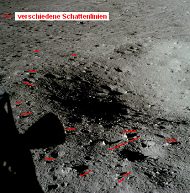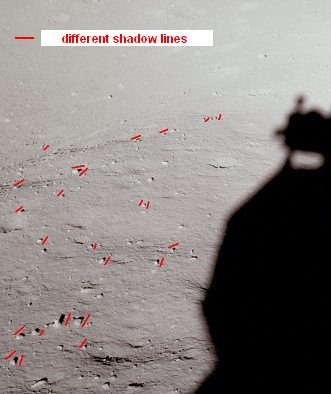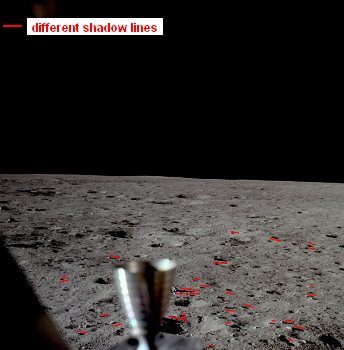
|
Apollo 11 photo no. AS11-37-5449.
According to NASA this photo shows the "lunar
surface" after the landing of Apollo 11 by the
window of Neil Armstrong. In the foreground one can
see a thruster. The shadows are non-uniform and by
this impossible.
One can see the photo here:
http://www.hq.nasa.gov/office/pao/History/alsj/a11/images11.html
http://www.hq.nasa.gov/office/pao/History/alsj/a11/AS11-37-5449.jpg

Photo composition:
-- the shadows are not parallel but the stones are
planted into the photo and the shadows are drawn
-- the background is much darker than the foreground
which is not possible with the extreme light
conditions on the moon.
So this photo is probably a landscape of the Earth
with a black-washed sky, with implanted stones and
with drawn shadows.
|
|
|
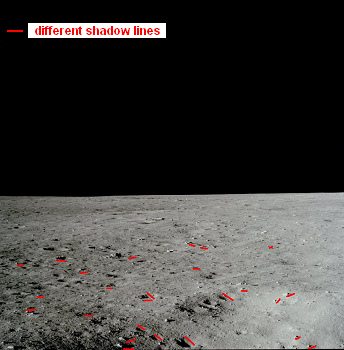
|
Apollo 11 photo no. AS11-37-5450.
According to NASA this is another photo of the
"lunar surface" after the landing of Apollo 11,
right of the photo before (AS11-37-5449). The photo
is taken by a window of the "Lunar Module". But the
chaos of shadows can be detected easily.
One can see the photo here:
http://www.hq.nasa.gov/office/pao/History/alsj/a11/images11.html
http://www.hq.nasa.gov/office/pao/History/alsj/a11/AS11-37-5450.jpg

Photo composition:
-- the shadows are not parallel, but the stones are
implanted and the shadows are drawn
-- the background is much darker than the foreground
which is not possible with the extreme light
conditions on the moon.
So this photo is probably a landscape of the Earth
with a black-washed sky, with implanted stones and
with drawn shadows.
|
|
|

|
Apollo 11 photo no. AS11-37-5451:
According to NASA this is another photo of the
"lunar surface" after the landing of Apollo 11, this
time with a big shadow of the "Lunar Module". With a
closer look one can see also here a chaos of
shadows.
One can see the photo here:
http://www.hq.nasa.gov/office/pao/History/alsj/a11/images11.html
http://www.hq.nasa.gov/office/pao/History/alsj/a11/AS11-37-5451.jpg
http://www.hq.nasa.gov/office/pao/History/alsj/a11/AS11-37-5451HR.jpg
Look the close-up:
Apollo 11 photo no. AS11-37-5451: the close-up shows
the chaos of shadows:

Photo composition:
So, also this photo is a photo composition: There
was taken a photo of a desert landscape with a
crater on the Earth, then the sky was black-washed,
then was drawn the big shadow which is said to
correspond to the "Lunar Module", then were
implanted the stones and then were drawn the wrong
shadows. It seems that the NASA manipulators had no
idea that shadows go parallel or centrical.
|
|
|
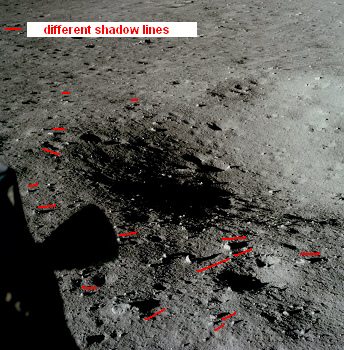
|
Apollo 11 photo no. AS11-37-5452:
According to NASA this is another photo of the
"lunar surface" after the landing of Apollo 11, this
time directly under the window of "astronaut" Neil
Armstrong with an Eastern part of a crater. But also
here is a chaos of shadows, and this indicates that
this is a bad photo composition.
One can see the photo here:
http://www.hq.nasa.gov/office/pao/History/alsj/a11/images11.html
http://www.hq.nasa.gov/office/pao/History/alsj/a11/AS11-37-5452.jpg

Photo composition:
-- the shadows of the stones have shadows in very
different directions which indicates that this is a
photo composition.
The photo composition is simple: One takes a photo
of a desert landscape in Chile or in Peru, then the
big shadow of the "Lunar Module" is painted, then
the stones are implanted, and then the shadows are
drawn. Unfortunately the NASA manipulators did not
know that the shadows are parallel or centrical.
This was not so important, the champagne during the
mood of champagne was more important...
|
|
|
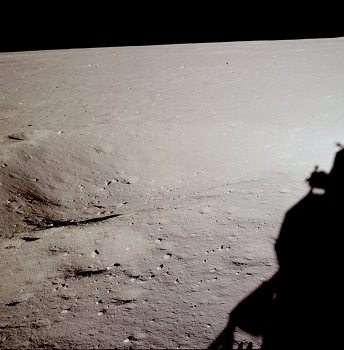
|
Apollo 11 photo no. AS11-37-5453:
According to NASA this is another photo of the
"lunar surface" directly under the window of
"astronaut" Neil Armstrong, now with the Western
part of the crater. The shadow of the "lunar module"
is the same as on photo AS11-37-5451, and also the
chaos of shadows is the same.
One can see the photo here:
http://www.hq.nasa.gov/office/pao/History/alsj/a11/images11.html
http://www.hq.nasa.gov/office/pao/History/alsj/a11/AS11-37-5453.jpg
http://www.hq.nasa.gov/office/pao/History/alsj/a11/AS11-37-5453HR.jpg

Photo composition:
-- the shadows of the stones have shadows in very
different directions which indicates that this is a
photo composition.
The close-up shows it clearly:
|
|
|
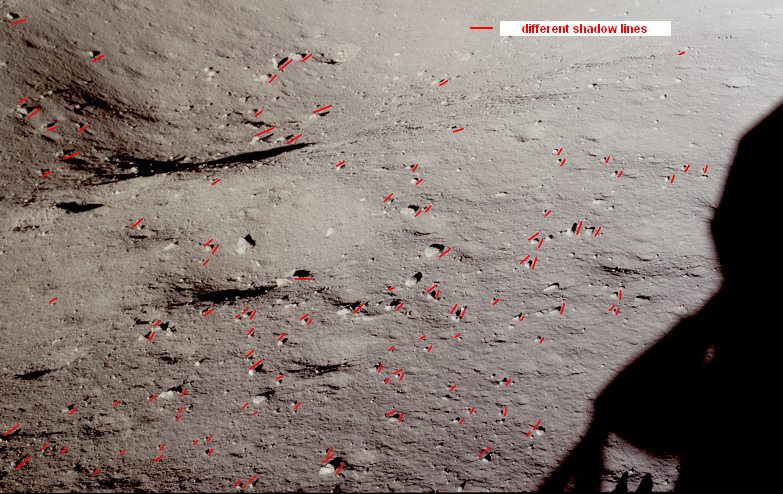
Apollo 11 photo no. AS11-37-5453: close-up of the
chaos of shadows on the photo with the Western part
of the crater which according to NASA was visible by
the window of Neil Armstrong of the "Lunar Module"
|
|
|
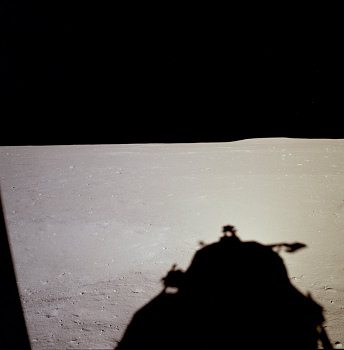
|
Apollo 11 photo
no. AS11-37-5454: view over the "lunar landscape"
with the complete long shadow of the "Lunar
Module". NASA claims that this photo is taken by
Edwin ("Buzz") Aldrin. The chaos of shadows is
remaining the same, and by this also this photo is
a photo composition with drawn shadows.
One can see the photo here:
http://www.hq.nasa.gov/office/pao/History/alsj/a11/images11.html
http://www.hq.nasa.gov/office/pao/History/alsj/a11/AS11-37-5454.jpg
http://www.hq.nasa.gov/office/pao/History/alsj/a11/AS11-37-5454HR.jpg

Photo composition:
-- the shadows of the stones have shadows in very
different directions which indicates that this is
a photo composition.
The close-up once again shows it clearly:
|
|
|
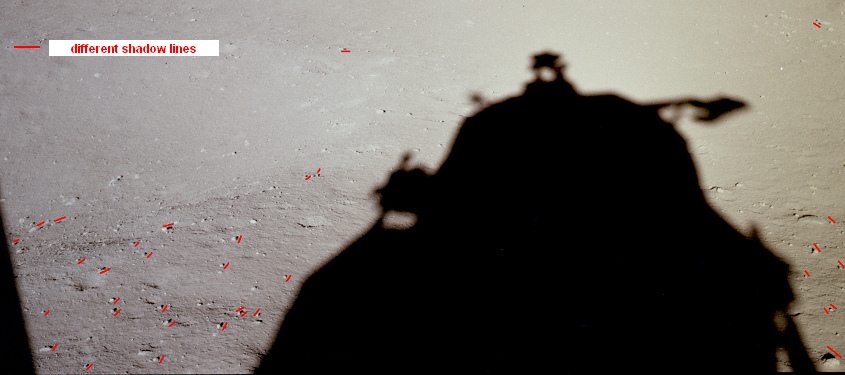
Apollo 11 photo no. AS11-37-5454: view over the
"lunar landscape" with the complete long shadow of
the "Lunar Module".
The chaos of shadows in a large size.
|
|
|
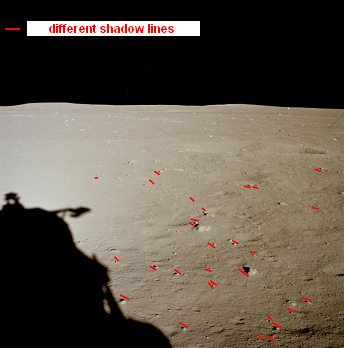
|
Apollo 11 photo no. AS11-37-5455:
view over the "lunar landscape" further to the
right, the chaos of shadows remains, the photo
composition remains a fact.
One can see the photo here:
http://www.hq.nasa.gov/office/pao/History/alsj/a11/images11.html
http://www.hq.nasa.gov/office/pao/History/alsj/a11/AS11-37-5455.jpg

Photo composition:
-- the shadows of the stones have shadows in very
different directions which indicates that this is a
photo composition
-- add to this the left part of the photo is
brighter than the right part which is not possible
with the extreme light on the moon.
|
|
|
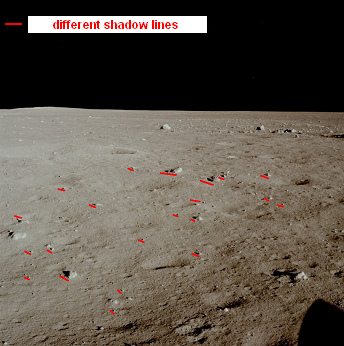
|
Apollo 11 photo no. AS11-37-5456:
Now one can see again further to the right, and NASA
presumes that the boulders came from the crater's
impact. And lower at the right side there can be
seen a part of a thruster NASA claims. But the
chaos of shadows remains, and with this also the
photo composition with the drawn shadows.
One can see the photo here:
http://www.hq.nasa.gov/office/pao/History/alsj/a11/images11.html
http://www.hq.nasa.gov/office/pao/History/alsj/a11/AS11-37-5456.jpg

Photo composition:
-- the shadows of the stones have shadows in very
different directions which indicates that this is a
photo composition
-- add to this the left part of the photo is
brighter than the right part which is not possible
with the extreme light on the moon.
It's very simple: The landscape is taken from the
Earth, the sky is black-washed, the peace of the
thruster is drawn, the stones are implanted, and the
shadows are drawn. |
|
|
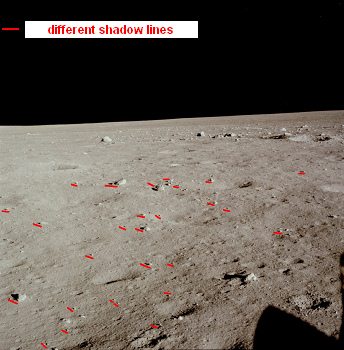
|
Apollo 11 photo no. AS11-37-5457:
On this photo one can see further to the right. The
chaos of shadows remains, and the photo composition
also remains.
One can see the photo here:
http://www.hq.nasa.gov/office/pao/History/alsj/a11/images11.html
http://www.hq.nasa.gov/office/pao/History/alsj/a11/AS11-37-5457.jpg

Photo composition:
-- the shadows of the stones have shadows in very
different directions which indicates that this is a
photo composition
-- add to this the left part of the photo is
brighter than the right part which is not possible
with the extreme light on the moon.
|
|
|

|
Apollo 11 photo no. AS11-37-5458:
The photo shows more or less the same "lunar
landscape".
One can see the photo here:
http://www.hq.nasa.gov/office/pao/History/alsj/a11/images11.html
http://www.hq.nasa.gov/office/pao/History/alsj/a11/AS11-37-5458.jpg

Photo composition:
-- the shadows of the stones have shadows in very
different directions which indicates that this is a
photo composition
-- add to this the left part of the photo is
brighter than the right part which is not possible
with the extreme light on the moon.
|
|
|
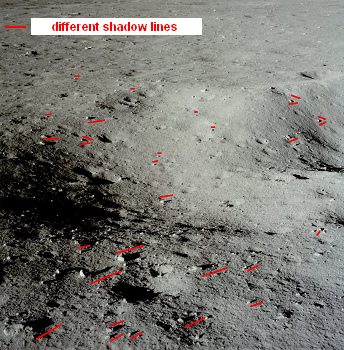
|
Apollo 11 photo no. AS11-37-5459:
Now NASA claims that Edwin Aldrin gave the camera to
Neil Armstrong and Neil had taken another photo of
the crater by his window. The chaos of shadows on
the crater is the same as in the beginning, and this
indicates the photo composition with drawn
shadows...
One can see the photo here:
http://www.hq.nasa.gov/office/pao/History/alsj/a11/images11.html
http://www.hq.nasa.gov/office/pao/History/alsj/a11/AS11-37-5459.jpg

Photo composition:
-- the different shadow lines indicate all that this
photo is a photo composition with shadows drawn by
hand. The photo is almost the same as photo no.
AS11-37-5452. The shadows again cross almost in an
angle of 90°
-- add to this the right part of the photo is
brighter than the left part which is not possible
with the extreme light on the moon.
|



